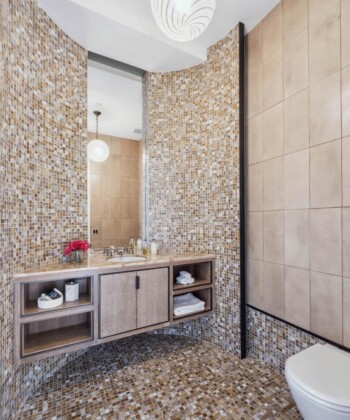Downsizing is passé. Boomer buyers of luxury condominiums are not inclined to manage a large house any longer, but they’re not looking to squeeze into two-bedroom, two-bath flats either.
“They want everything they have in their big home,” plus maintenance and service, says Jay Phillip Parker, CEO of Douglas Elliman’s Florida brokerage.
Downsizing comes “at an emotional cost,” explains Dr. Neil Applebaum, a clinical psychologist in Fort Lauderdale, Florida. “There is a tendency now for empty nesters to be reluctant to downsize; they want to give up the responsibilities and chores of a large home but still maintain the creature comforts they are used to…and then some.”
Enter the trophy condo. Affluent buyers in their 50s and 60s are seeking to feather house-sized nests in luxe high-rises with tall ceilings, walls of glass, designer kitchens, sumptuous baths, and oversized glass-railed balconies with sweeping views. Five-star services and amenities, from valets to spas, art studios, golf simulators, and private restaurants, add to the allure.

A model living room at the Ritz-Carlton Safavieh, in North Hills, New York.
In Miami, over the past decade there has been a “remarkable and distinct evolution in the sophistication of the condo market,” Parker says. “They didn’t make four-bedroom condos 10 years ago.” Gym rooms with a treadmill or two have morphed into full-service health clubs. Hotel-style services have escalated. Top buildings have gate attendants, valets, concierges, even “someone to greet you at the elevator and send you to your floor.”
“Developers are looking to distinguish themselves,” Parker says, providing “comfort, privacy, and exclusivity.” While apartments have gotten bigger, buildings have fewer units. “It is much harder to deliver luxury in a 500-unit building than in a 60- to an 80-unit building” where “the staff knows your name.”
Three- or four-bedroom condos with dens or media rooms are in vogue. At the upcoming 38-story 2000 Ocean, a boutique condo rising just north of Miami Beach, each $2.8 to $3 million turnkey 3,000-square-foot unit spans half a floor, accessed by an elevator opening onto a private vestibule. “It is a house in the sky,” says Shahab Karmely, the developer.

The Ritz-Carlton South Beach’s art room.
At the neighboring super-luxe Regalia, where prices start at $7.2 million, each of the 39 four-bedroom, five-and-and-a-half bath units occupies an entire floor, measuring 7,600 square feet, including a wavy 360-degree wraparound terrace with views of the Atlantic, the Intracoastal Waterway, the mansions of Golden Beach, plus the Miami and Miami Beach skylines. Penthouses boast private pools.
Coconut Grove’s new Park Grove condominium has windows and doors that retract for indoor-outdoor living. Private balconies are expansive enough for outdoor kitchens, dining, and lounging. Celebrity chef Michael Schwartz will dazzle palates at Park Grove’s restaurant. At the Ritz-Carlton South Beach, a Frauscher yacht will ferry residents to the Eden Roc/Nobu beach club or to dinner at a waterside restaurant. On the 72nd floor of 1000M, an ultra-luxury condominium coming to Chicago, residents will be able to savor the views, live music, and cocktails at Club 1000, a private full-service bar and lounge.
Sixteen buyers, mostly empty nesters, combined two $2 million–plus 1,700-square-foot units in the first phase at the Ritz-Carlton Residences in North Hills, New York, a new gated 120-unit condominium community with a grand clubhouse and pool 20 miles east of Manhattan. The demand for house-sized units was so strong that for phase two, the developer, RXR Realty, increased unit size: 75 percent of them range from 2,500 to 4,000 square feet.

A rendering of the Park Grove, in Coconut Grove, Florida.
Coming from a 7,000-square-foot house, buyers can’t see moving into an 1,800-square-foot apartment, says Joe Graziose, RXR’s executive vice president of residential development. “They don’t like to feel stuffed in.” Downsizers still want a foyer, commodious closets in the master suite, an oversized master bath, a second bedroom, plus a den, with room for grandchildren to visit. “They are willing to give up their private movie theater because the community clubhouse has one,” Graziose says. “They want amenities they are used to living with that they don’t want to be the keeper of. They don’t want to have to maintain the pool or the tennis court or the golf course. They want a community, which we are creating.”
“Moving to a condo that is just as large or larger than their house is welcoming to the children and grandchildren, giving it the feeling of home,” says Dr. Applebaum.
At 111 Murray, a new 157-unit luxe high-rise amid Tribeca’s vibrant arts and cultural scene, many empty-nest buyers are relocating to be closer to their New York City–based children and grandchildren. “Their children prefer to be downtown,” says Emily Sertic of Douglas Elliman, the new condo’s director of sales. “It just makes it easier” for them to visit.

The lobby at the Park Grove.
The superluxury tower’s 20,000 square feet of amenities provide extra incentives, from a residents’ lounge to a patisserie, a private dining room with a demonstration kitchen, a 75-foot lap pool, a children’s splash pool and playroom, a teen room, a spa, a movement studio, a hammam, a meditation area, yoga and Pilates classes, and a Drybar hair salon. Landscaped gardens blend the interiors and the outdoors.
Views of the Brooklyn Bridge, the Hudson River, and the Empire State Building are also vital to Sertic’s clients, who want a “trophy property” with a living room that can fit a grand piano, a third bedroom that can be converted to a media room, and a concierge who can arrange private jet service, theater tickets, or a private chef. “By no means are they downsizing the quality of their lifestyles and expectations,” Sertic says. “Deep down, people want things to be simpler, but they don’t want to compromise in standard and quality of the lifestyle they are accustomed to.”






































